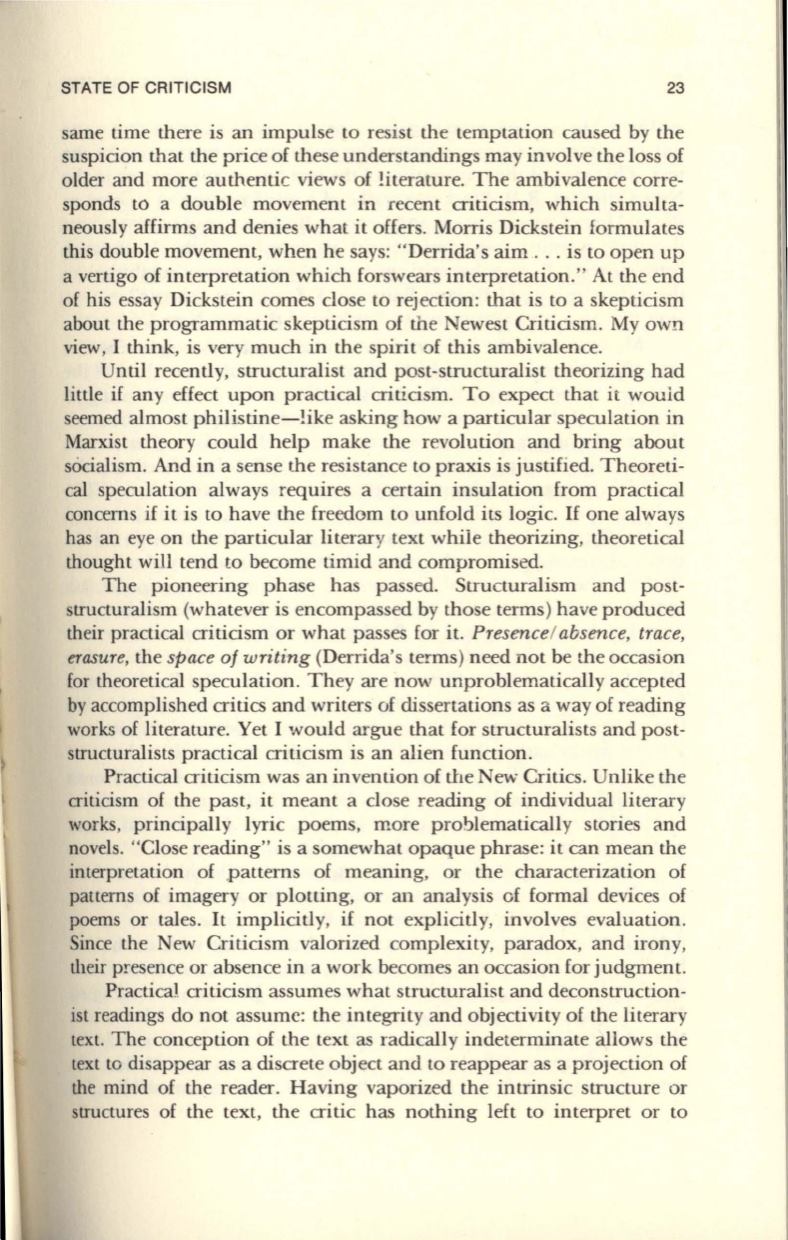
STATE OF CRITICISM
23
same time there is an impulse to resist the temptation caused by the
suspicion that the price of these understandings may involve the loss of
older and more authentic views of literature. The ambivalence corre–
sponds to a double movement in recent criticism, which simulta–
neously affirms and denies what it offers. Morris Dickstein formulates
this double movement, when he says: "Derrida's aim .. . is to open up
a vertigo of interpretation which forswears interpretation." At the end
of his essay Dickstein comes close to rejection: that is to a skepticism
about the programmatic skepticism of the Newest Criticism. My own
view, I think, is very much in the spirit of this ambivalence.
Until recently, structuralist and post-structuralist theorizing had
little if any effect upon practical criticism. To expect that it would
seemed almost philistine-!ike asking how a particular speculation in
Marxist theory could help make the revolution and bring about
socialism. And in a sense the resistance to praxis is justified. Theoreti–
cal speculation always requires a certain insulation from practical
concerns if it is to have the freedom to unfold its logic.
If
one always
has an eye on the particular literary text while theorizing, theoretical
thought will tend to become timid and compromised.
The pioneering phase has passed. Structuralism and post–
structuralism (whatever is encompass d by those terms) have produced
their practical criticism or what passes for it.
Presence/ absence, trace,
erasure,
the
space of writing
(Derrida's terms) need not be the occasion
for theoretical speculation. They are now unproblematically accepted
by accomplished critics and writers of dissertations as a way of reading
works of literature. Yet I would argue that for structuralists and post–
structuralists practical criticism is an alien function.
Practical criticism was an invention of the New Critics. Unlike the
criticism of the past, it meant a close reading of individual literary
works, principally lyric poems, more problematically stories and
novels. "Close reading" is a somewhat opaque phrase: it can mean the
interpretation of patterns of meaning, or the characterization of
patterns of imagery or plotting, or an analysis of formal devices of
poems or tales.
It
implicitly, if not explicitly, involves evaluation.
Since the New Criticism valorized complexity, paradox, and irony,
their presence or absence in a work becomes an occasion for judgment.
Practica~
criticism assumes what structuralist and deconstruction–
ist readings do not assume: the integrity and objectivity of the literary
text. The conception of the text as radically indeterminate allows the
textLO disappear as a discrete object and to reappear as a projection of
the mind of the reader. Having vaporized the intrinsic structure or
structures of the text, the critic has nothing left to interpret or to


